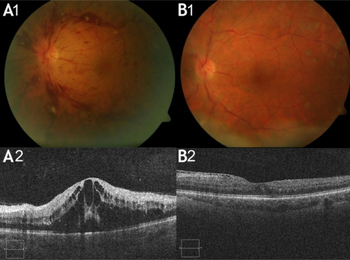Central retinal vein occlusion
| Central retinal vein occlusion | |
|---|---|
| Other names: Retinal vein occlusion | |
 | |
| Diagram of the eye; retinal vein is number 21. | |
Central retinal vein occlusion, also CRVO, is when the central retinal vein becomes occluded, usually through thrombosis. The central retinal vein is the venous equivalent of the central retinal artery and both may become occluded.[1] Since the central retinal artery and vein are the sole source of blood supply and drainage for the retina, such occlusion can lead to severe damage to the retina and blindness, due to ischemia (restriction in blood supply) and edema (swelling).[2]
CRVO can cause ocular ischemic syndrome. Nonischemic CRVO is the milder form of the disease. It may progress to the more severe ischemic type.[3] CRVO can also cause glaucoma.
Signs and symptoms
Symptoms of Retinal vein occlusion include sudden blurring or vision loss in one eye.[4]
Diagnosis
Despite the role of thrombosis in the development of CRVO, a systematic review found no increased prevalence of thrombophilia (an inherent propensity to thrombosis) in patients with retinal vascular occlusion.[5]
Treatment

Treatment consists of Anti-VEGF drugs like Lucentis or intravitreal steroid implant (Ozurdex) and Pan-Retinal Laser Photocoagulation usually. Underlying conditions also require treatment. CRVO without ischemia has better visual prognosis than ischemic CRVO.
A systematic review studied the effectiveness of the anti-VEGF drugs ranibizumab and pagatanib sodium for patients with non-ischemic CRVO.[6] Though there was a limited sample size, participants in both treatment groups showed improved visual acuity over 6 month periods, with no safety concerns.[6]
See also
References
- ↑ Ophthalmology at a Glance, Jane Olver & Lorraine Cassidy, Blackwell Science 2005.[page needed]
- ↑ Hayreh, Sohan Singh; Zimmerman, M. Bridget; Podhajsky, Patricia (1994). "Incidence of Various Types of Retinal Vein Occlusion and Their Recurrence and Demographic Characteristics". American Journal of Ophthalmology. 117 (4): 429–41. doi:10.1016/S0002-9394(14)70001-7. PMID 8154523.
- ↑ Central Retinal Vein Occlusion at eMedicine
- ↑ "Retinal vein occlusion: MedlinePlus Medical Encyclopedia". medlineplus.gov. Archived from the original on 14 July 2022. Retrieved 21 August 2022.
- ↑ Romiti, Giulio Francesco; Corica, Bernadette; Borgi, Marco; Visioli, Giacomo; Pacella, Elena; Cangemi, Roberto; Proietti, Marco; Basili, Stefania; Raparelli, Valeria (2020). "Inherited and Acquired Thrombophilia in Adults with Retinal Vascular Occlusion: A Systematic Review and Meta-Analysis". Journal of Thrombosis and Haemostasis. Online first (12): 3249–3266. doi:10.1111/jth.15068. hdl:2434/809252. PMID 32805772. S2CID 221163392.
- ↑ 6.0 6.1 Braithwaite T, Nanji AA, Lindsley K, Greenberg PB (2014). "Anti-vascular endothelial growth factor for macular oedema secondary to central retinal vein occlusion". Cochrane Database Syst Rev. 5 (5): CD007325. doi:10.1002/14651858.CD007325.pub3. PMC 4292843. PMID 24788977.
External links
| Classification | |
|---|---|
| External resources |